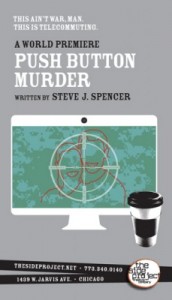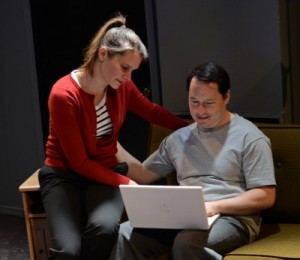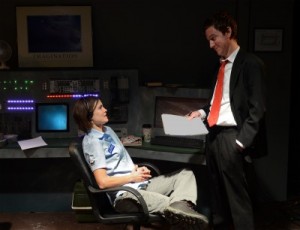
 Recommended *** Steven J. Spencer’s play “Push Button Murder” perhaps tries to do much. Its main thread is the work of two “decorated” drone pilots “who don’t exist on paper” called Roy (Derek Garza) and Becky (Meredith Rae Lyons) who Spencer uses to explore, among numerous other things, why drone pilots commit suicide at higher rates than those who fly combat missions overseas. The high suicide and PTSD rate among drone pilots is a known phenomenon, and Spencer turns it into an interesting, tense, dramatic, and fruitful question. However, there is a bizarre subplot about a bankrupt teacher turned blogger, and violent apolitical revolutionary which seems to suggest that the drone pilots’ willingness to do their work is linked to modern pedagogy, our heavy reliance on electronics in daily life, and the failure of social activists.
Recommended *** Steven J. Spencer’s play “Push Button Murder” perhaps tries to do much. Its main thread is the work of two “decorated” drone pilots “who don’t exist on paper” called Roy (Derek Garza) and Becky (Meredith Rae Lyons) who Spencer uses to explore, among numerous other things, why drone pilots commit suicide at higher rates than those who fly combat missions overseas. The high suicide and PTSD rate among drone pilots is a known phenomenon, and Spencer turns it into an interesting, tense, dramatic, and fruitful question. However, there is a bizarre subplot about a bankrupt teacher turned blogger, and violent apolitical revolutionary which seems to suggest that the drone pilots’ willingness to do their work is linked to modern pedagogy, our heavy reliance on electronics in daily life, and the failure of social activists.
Unfortunately, even within the script, the links are either impossible to understand or completely fallacious: for example, Stacy (Amy Johnson) complains to her husband, Mike (Ben Veatch) that her students (Kasia Januszewski) simply type everything she says, while Becky, though she considers herself cynical and amoral, often balks at the order to take out a target if she believes the person isn’t a threat. Spencer also gets sidetracked with the possibility that the air-force is using drones to spy on, and may eventually target, our allies, and even, private American citizens.
Fortunately, director Ron Marra keeps the focus on the two drone pilots, and the foreign missions they fly from Ohio. Firstly, Mr. Garza and Ms. Lyons are two extremely charismatic actors who, in turns of pure presence, dominate the stage. This is especially fortunate because Roy’s character is woefully underwritten, and Garza has to slide by on pure charm of which he has plenty. However, Ms. Lyons charisma sometimes becomes a problem as she, occasionally, lets it do all the work, slipping into speech and gestures that seem heavily affected, especially if what she is saying is banal (one of the tensions in their situation is that they are both “traumatized” and “bored”). That said, when it really matters, she delivers: her description of a near death experience, explanation of her atheism, and why she continues to do her job, despite her conviction that it is immoral and making the world an increasingly unsafe place, are delivered with great force and constitute, in the moment, the dramatic high-points and satisfaction of the play. She is also strong when tormenting Preston (Andrew Bailes), a mysterious character who the air force has contracted “to find ways to make their job easier and less stressful.”
Mr. Bailes may lack the natural charisma of Garza and Lyons, but his character doesn’t necessarily call for it, and he more than makes up for it with a highly skilled and diligent performance. His increasing terror as he hears them describe their job, and as he experiences, sometimes first-hand, the moral and psychological damage that the poisonous mix of trauma and boredom have done to Roy and Becky is subtle, but still the dominant, overpowering, sensation with which the audience walks away. Ultimately, his ability to make himself the lens through which the audience sees Becky and Roy is the reason this play succeeds.
As to the subplot, the dialogue is so underwritten, a fact emphasized rather than helped by the dialectal strength of the script in the exchanges between Becky, Roy, and Preston, that the actors seem rather unsure how to handle it. Compare Becky describing her near death experience: “I saw some lights, but not the light” with the Mike saying “I know where you live. That is literally the scariest sentence in the English language.” Becky’s leaves us (the audience) thinking about her character, profession, psyche, conscience, religious and political orientation (or lack thereof), and the ambiguities in her character whereas Mike’s makes us think “Really? What about, ‘I love you’ or “Your credit card has been declined?” Ms. Johnson and Ms. Januszewski do deliver their lines with great comic timing, and make us laugh, but ultimately they don’t fully compensate for the scripts deficiencies.
Technically (Technical Director: Brian Ruby), the show is excellent which is typical of The Side Project, and fortunate, because they have such a difficult space. I don’t suppose anyone in the audience will know what a drone station looks like (I certainly don’t), but it was represented plausibly (Set design: Ashley Ann Woods) alongside a car, a protest in the woods, a domestic space, and targets in the Middle Eastern desert. This was done both with extremely sophisticated lighting (Mike Smith) and with music and sound (Stephen Gawrit). I particularly liked the choice of Leonard Cohen playing dimly in the background at one point, semi-consciously bringing to noble but Syphsius-like nature of social activism, the ennui of modern life, and the decay of morality in public, professional, and personal conduct: all concepts which seem to hang around the periphery of Spencer’s script.
“Push Button Murder” is running at “The Side Project” which is located at 1439 W. Jarvis Avenue through February 8, 20015. Performances are Thursday’s through Saturday at 7:30 pm, and on Sunday at 3:00 pm. Regular Tickets are $20. $15 for Students and Seniors. They can be purchased at http://www.thesideproject.net/detail.php?show=202 or by calling 773-340-0140. Unsold Rush Tickets are available at the door with a Rogers Park ID: 60625 or 60645.
To see what others are saying, visit www.theatreinchicago.com, go to Review Round-up and click at “Push Button Murder”.






More Stories
“Guys and Dolls”
“Dummy in Diaspora”
“The Magic School Bus: Lost in the Solar System”